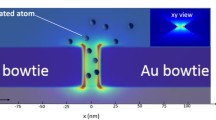Abstract
Within a mid-IR few-cycle laser, the generation of MHz isolated attosecond pulses via nanoplasmonic field enhancement in a structure that consisted of a metal coupled nanoparticle-disk, an insulator spacer, and a thin metal film is theoretically investigated. The interaction between the localized surface plasmons caused by the coupled nanodisks and the metal layer results in increased electric field. The resonance wavelengths of these two types of surface plasmons supported by the nanostructure are tailored by changing the coupled nanoparticle-disk size and the material type. Numerical calculations are used to optimize nanostructure and attain plasmonic field enhancement factors up to 86. The HHG process is studied by the time–frequency analysis. Our studies show that only short trajectories contribute to HHG and also, the chirp of these harmonics is very low. As a result, an isolated 40 as pulse without phase compensation is obtained directly by superposing the chirp-free high-order harmonics.













Similar content being viewed by others
Data Availability
The datasets generated during and/or analyzed during the current study are available from the corresponding author on reasonable request.
References
Du H, Wang H, Hu B (2010) Isolated short attosecond pulse generated using a two-color laser and a high-order pulse. Phys Rev A 81:063813. https://doi.org/10.1103/PhysRevA.81.063813
Corkum PB (1993) Plasma perspective on strong field multiphoton ionization. Phys Rev Lett 71:1994. https://doi.org/10.1103/PhysRevLett.71.1994
Kim S, Jin J, Kim YJ, Park IY, Kim Y, Kim SW (2008) High harmonic generation by resonant plasmon field. Nature 453:757–760. https://doi.org/10.1038/nature0701
Park IY et al (2011) Plasmonic generation of ultrashort extreme-ultraviolet light pulses. Nat Photonics 5:677–681. https://doi.org/10.1038/nphoton.2011.258
Ebadian H, Mohebbi M (2017) Extending the high-order-harmonic spectrum using surface plasmon polaritons. Phys Rev A 96:023415. https://doi.org/10.1103/PhysRevA.96.023415
Ebadian H, Mohebbi M (2018) Plasmonic nanostructure assisted HHG in NIR spectrum and thermal analysis. J Phys D: Appl Phys 51:075307. https://doi.org/10.1088/1361-6463/aaa651
Kelly KL et al (2003) Optical properties of the metals nanoparticles: the influence of size, shape and dielectric environment. J Phys Chem B 107:668–677. https://doi.org/10.1021/jp026731y
Protopapas M et al (1997) Atomic physic with super-high intensity lasers. Rep Prog Phys 60:389–486. https://doi.org/10.1088/0034-4885/60/4/001
Ebadian H, Mohebbi M (2016) Strong electric field enhancements in asymmetric metallic nanostructures and high-order harmonic generation. Appl Opt 55(28):8035–8041. https://doi.org/10.1364/AO.55.008035
Mohebbi M, Nazarpoor Malaei S (2015) Electron path control of high-order harmonic generation by a spatially inhomogeneous. J Mod Opt 63:643–652. https://doi.org/10.1080/09500340.2015.1088586
Hekmatara SH, Mohebbi M, Rahpeyma J (2014) Extension of high-order harmonic generation cutoff via control of chirped laser pulses in the vicinity of metal nanostructure media. RSC Adv 4:59064–59070. https://doi.org/10.1039/C4RA08052A
Chu Y, Crozier KB (2009) Experimental study of the interaction between localized and propagating surface plasmons. Opt Lett 34(3):244–246. https://doi.org/10.1364/OL.34.000244
Bohn LJ, Nesbitt JD, Gallagher A (2001) Field enhancement in apertureless nearfield scanning optical microscopy. J Opt Soc Am A 18:2998–3006. https://doi.org/10.1364/JOSAA.18.002998
Taflove A, Brodwin ME (1975) IEEE Trans Microwave Theory Tech 23:623–630. https://doi.org/10.1109/TMTT.1975.1128640
Kunz KS, Luebbers RJ (1993) The finite difference time domain method for electromagnetics. CRC, Boca Raton, FL
Sabaawi AMA, Tsimenidis CC and Sharif BS (2012) Bow-tie nanoarray rectenna: Design and optimization 6th Eur. Conf. on Antennas and Propagation (EUCAP): 1975–1978
Polyanskiy MJ (2014) accessed. http://www.RefractiveIndex.info
Rechberger W et al (2003) Optical properties of two interacting gold nanoparticles. Opt Commun 220:137–141. https://doi.org/10.1016/S0030-4018(03)01357-9
Noguez C (2007) Surface plasmons on metal nanoparticles: the influence of shape and physical environment. J Phys Chem C 111(10):3806–3819. https://doi.org/10.1021/jp066539m
Stuart HR, Hall DG (1998) Enhanced dipole-dipole interaction between elementary radiators near a surface. Phys Rev Lett 80:5665. https://doi.org/10.1103/PhysRevLett.80.5663
Wooten F. Optical properties of solids. Academic Press; 1972
Feit MD (1982) Solution of the Schrödinger equation by a spectral method. J Comput Phys 47:412–433. https://doi.org/10.1016/0021-9991(82)90091-2
Chirila CC et al (2010) Emission times in high-order harmonic generation. Phys Rev A 81:033412. https://doi.org/10.1103/PhysRevA.81.033412
Funding
No funding was received to assist with the preparation of this manuscript.
Author information
Authors and Affiliations
Contributions
All authors have participated in (a) conception and design or analysis and interpretation of the data; (b) drafting the article or revising it critically for important intellectual content; and (c) approval of the final version.
Corresponding author
Ethics declarations
Conflict of Interest
The authors declare that they have no conflict of interest.
Ethical Approval
Not applicable.
Consent to Participate
Informed consent was obtained from all authors.
Consent to Publish
The authors confirm that there is informed consent to the publication of the data contained in the article. We confirm that this work is original and has not been published elsewhere, nor is it currently under consideration for publication elsewhere.
Additional information
Publisher’s Note
Springer Nature remains neutral with regard to jurisdictional claims in published maps and institutional affiliations.
Rights and permissions
About this article
Cite this article
Shahnavaz, N., Mohebbi, M. The Large Near-Field Enhancement due to Strong Coupling Between the LSP on the Metal Coupled Nanodisks and on the Gold Film for Short Attosecond Pulse Generation. Plasmonics 16, 305–314 (2021). https://doi.org/10.1007/s11468-020-01340-2
Received:
Accepted:
Published:
Issue Date:
DOI: https://doi.org/10.1007/s11468-020-01340-2




